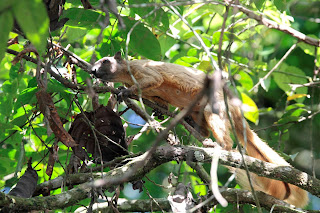
Hoping to confirm a nesting, I was again back in Bukit Rengit but alas it was not to be. Later met Kamal and Zul at the Bridge and they were telling me they heard the Hooded Pitta.....surprise in the month of June?
It was a very eventful trip. Firstly in the wee morning when everything was still in "slow motion" I got a glimpse of this male Crested fireback struting across the trail 100m away. Usually it is the last to cross in its flock so I missed the entire procession. This is the second time I have seen them in Bukit Rengit.

The Emerald pigeon is common to see - scuttering on the deserted road picking up pebbles and seeds droppings also in the wee morning. Later my price capture of this barbet a juvenile pale featured......which I cannot match its looks with the 11 listed Barbets but more like a Blue throated though. Now searching the internet it was recorded in
http://www.malaysianbirds.com/bird-family/barbet.htm by my sifu that the Blue-throated Barbet is a verified sighting here particularly Bukit Rengit and Bukit Tinggi....... way south of Thailand. Anybody wish to argue about that. This would make it 12 subspecies for Malaysia.
I have yet to see my last Barbet - the Red-crowned. Please give me a howler if you guys see one.
An odd couple of the Ochraceous Bulbul and Checker-throated Woodie were seen flying together. There was also a pair of Rufous Piculet which stopped for awhile for me to snap a few shots .
The Broadbills are quite approachable today and came out to see what the commotion of the giant squirrel feeding on berries again. In fact everybody is waiting for the squirrel to move along to feast.
The Lesser Cuckoo-shrike was chased out by bulbuls from the fruiting tree. Earlier I got my lifer of the Bar-bellied Cuckoo-shrike abate a 30m shot from a hillside. Enough to id it after close scrutiny of my photos back home.
A pair of resident Red-bearded Bee-eater was obliging to my playback. So overall not bad an outing. The ever obliging Sooty-capped Babbler and Buff-vented Bulbul are always there.
Bluebird or Maroon-breasted........

 The common Buff-vented is the dominating pair seen at the fruiting tree because of its fiery look........ they stayed the longest
The common Buff-vented is the dominating pair seen at the fruiting tree because of its fiery look........ they stayed the longest
 The Olived-winged and Black headed are the other common bulbuls recorded. Other bulbuls seen were the Striped-throated, Hairy-backed and Yellow-bellied.......
The Olived-winged and Black headed are the other common bulbuls recorded. Other bulbuls seen were the Striped-throated, Hairy-backed and Yellow-bellied.......



















 \
\























